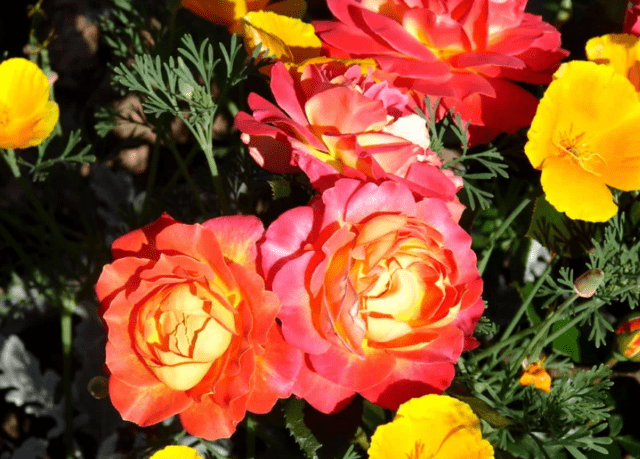Content
Rose floribunda Circus is an unpretentious variety with large, fragrant flowers in warm shades (from copper-yellow to red-pink). The culture is characterized by moderate winter hardiness and low maintenance requirements. Suitable for cultivation in the southern regions, in the middle zone, as well as in the North-West. Used in single plantings and compositions. The flowers are used for cutting as they remain fresh for 10–14 days.
History of selection
Rose floribunda Circus is a variety bred in 1956 by American breeder Herbert C. Swim. He worked on different varieties for more than 40 years - from 1941 to 1982. He took part in the creation of 115 varieties of roses, including 76 he received personally.
The Circus rose variety was bred by step-by-step crossing of representatives of several groups:
- hybrid tea;
- polyanthaceae;
- nutmeg.
When breeding the variety, G. Swim set the task of creating a variety that would not lose color in the sun. The result was a rose with orange petals, which, when burned, changed color to yellow with pinkish hues.
The plant combines the benefits of all original groups.The Circus variety is decorative and winter-hardy. The rose is also unpretentious and has good immunity to a number of diseases. Therefore, it can be grown in different regions of Russia, including in the North-West and in the middle zone.
Description of Floribunda Circus rose and characteristics
Rose Circus is a perennial flowering shrub of medium height - from 40 to 70 cm, less often up to 90 cm. The leaves are dark green in color, leathery, and have a pleasant glossy surface. They cover the rose bush generously and create a beautiful background. The shoots are erect, with a small number of thorns.
The buds are pointed, elongated. The flowers of the Circus variety are large, reaching 12–14 cm in diameter, double type, and consist of several rows of petals. The color in the center is copper-yellow, closer to the edges salmon-pink, during flowering the tones become more saturated - pink-red.
Floribunda Circus rose blooms abundantly: 3–10 flowers on each peduncle (height 50–60 cm). The aroma is pleasant, weakly expressed. Roses are suitable both for garden decoration and for flower bouquets: they last a long time when cut.

Circus flowers have bright, attractive colors
Main characteristics of the variety:
- medium-sized bush – 70–90 cm;
- terry buds, consist of 37–45 petals, their diameter is 5–8 cm, when blooming – 12–14 cm;
- the shape of the inflorescences is classic, cup-shaped;
- the aroma is weak, pleasant;
- the flowering period lasts from June to August;
- durability when cut – from 10 to 14 days;
- disease resistance is satisfactory;
- winter hardiness: zone 6 (up to -23 °C);
- Resistance to precipitation is high, buds bloom even in rainy weather.
Advantages and disadvantages of the variety
Hybrid tea rose Circus has both advantages and disadvantages. Gardeners especially value this variety for the following advantages:
- attractive large flowers of bright colors;
- low maintenance requirements;
- continuous and abundant formation of buds;
- resistance to rain;
- compactness;
- weak studs;
- Possibility of use for cutting.
Among the disadvantages of the floribunda rose variety Circus, flower growers highlight only certain points:
- weak aroma;
- average winter hardiness.
Reproduction methods
The main methods of propagating Floribunda Circus rose are cuttings and grafting. For a novice gardener, it is more convenient to propagate a flower using cuttings. They are obtained in late summer or early autumn. The sequence of actions is as follows:
- Cut off woody shoots from the rose.
- Get several cuttings up to 8 cm long.
- Make the top cut at a right angle, the bottom one oblique.
- Remove all thorns and lower leaves.
- Place in a solution of Epin or another growth stimulant for several hours.
- Plant in moist, fertile soil and grow at home until spring.
- At first, cover with a jar and water periodically.
- Transplant into the ground in mid-May.

Floribunda Circus cuttings can be grown in potato tubers
It is better to purchase seedlings from a trusted supplier, and after 2–3 years propagate several bushes by cuttings.
Growing and care
Floribunda Circus rose can be planted in mid-May, when there are no more return frosts; in the south, the procedure is carried out at the end of April. The landing site should be like this:
- well lit, even a faint shadow is undesirable;
- protected from the winds;
- without stagnation of moisture (not lowland);
- fertile (soil - light loam with a pH reaction from 5.5 to 7.3).
It is recommended to prepare the soil in the fall. The area is thoroughly cleaned, dug up with a shovel and covered with humus at the rate of 3-5 kg per 1 m2 or complex mineral fertilizer - 30-40 g per 1 m2. If the soil is heavy, you will need to add 500–700 g of sawdust or sand to the same area.

It is necessary to plant the floribunda Circus rose together with a lump of earth.
Dig several holes with a depth of at least 50 cm. The distance between them should be 50–60 cm, then the floribunda Circus rose bushes will be located as close to each other as possible. For less dense planting, the interval is increased to 80–100 cm.
Sequencing:
- Place a drainage layer of sand and small stones at the bottom of the hole.
- Root the seedling.
- Cover with fertile soil.
- Deepen the root collar by 2–3 cm, compact it a little.
- Pour over warm water (5–10 l).
- Mulch with peat, humus, sawdust.
Floribunda Circus rose is not too demanding to care for. Its shoots are covered with a waxy layer, so fluid loss is minimal. Watering is organized so that the surface layer of the soil remains slightly moist:
- if precipitation is light - weekly;
- during drought – 2 times a week;
- in the presence of rain - without additional irrigation.
During the dry period, it is also recommended to spray the leaves of the floribunda Circus rose with drops of water. It is better to do irrigation in the evening so that the sun's rays do not burn the plant.
Fertilizers are applied regularly (every 2-3 weeks) from late April to mid-July. They use a complex mineral remedy, for example, azofoska, alternating with organic matter (infusion of mown grass, humus). At the same time, fresh manure cannot be used, since the bush may “burn” and the leaves will turn yellow, which will affect flowering.
Pruning is carried out every spring.Remove weak, frost-damaged, old shoots. You also need to cut off those branches that grow inward and spoil the appearance of the bush. In summer, as the flower stalks wither, they are gradually removed. The cut areas are sprinkled with coal powder or treated in a solution of potassium permanganate, a fungicide.
At the beginning of October, the floribunda Circus rose must be prepared for wintering (except in the southern regions). Spruce branches are laid on the surface of the soil, branches are laid on it, and they are fixed to the ground. A frame is installed on top, on which cardboard, parchment or agrofibre is placed. In early spring, the shelter is removed so that the bush does not rot from excess moisture.

The blooming of the Circus rose will be continuous and abundant when fertilized every 2-3 weeks
Pests and diseases
Floribunda rose Circus is resistant to many diseases, but can suffer from powdery mildew and black spot. Signs of powdery mildew:
- the leaves are covered with a whitish coating;
- buds do not bloom;
- The rose stops developing and weakens.
The disease cannot be treated, so all affected shoots are immediately removed and burned. If the disease is advanced, the bush will have to be destroyed.
The main signs of black spot: dark brown spots on the leaves. They quickly expand and acquire yellowish edges. Then the leaves begin to turn yellow and fall off. For treatment, the affected shoots are removed, and the rest are treated with a fungicide:
- Bordeaux mixture;
- "Fitosporin";
- "Tattu";
- "Profit";
- "Maksim".
Among insects, aphids are especially dangerous for the floribunda circus rose. It is destroyed using insecticides:
- "Biotlin";
- "Aktara";
- "Confidor";
- "Match";
- "Fitoverm".
You can also use folk remedies to destroy pests - an infusion of tobacco dust, wood ash with laundry soap, garlic cloves, chili peppers, etc. The treatment is carried out in the evening. The weather should be dry and windless.
Application in landscape design
The Circus rose variety is suitable for decorating ceremonial places. These are gazebos, benches, lawns and other recreation areas. The bushes look good in a symmetrical planting at the entrance.

Floribunda rose Circus decorates the path in combination with dwarf conifers
A well-groomed lawn on a site may look uncomfortable due to too large, “uninhabited” space. Roses of different varieties are suitable for decoration.

Floribunda Circus enlivens the lawn and looks good against a green background
Roses can be complemented by any plants with bright, lush greenery. The bushes are neat, compact and not too tall.

The Circus rose variety also looks good when planted alone.
Conclusion
Rose floribunda Circus is one of the best varieties that is suitable for beginning gardeners. The bushes do not require care. It is enough for them to provide regular watering and fertilizing until mid-July. It is also worth thinking about winter shelter in advance. Caring for a Circus rose is exactly the same as caring for other garden flowers.
Reviews with photos about rose floribunda Circus










